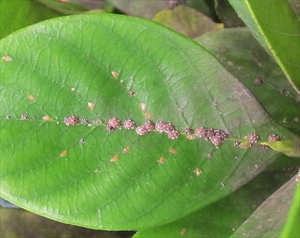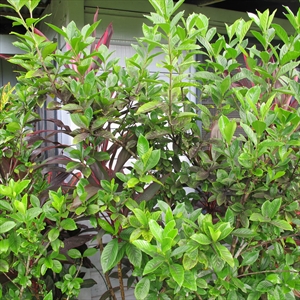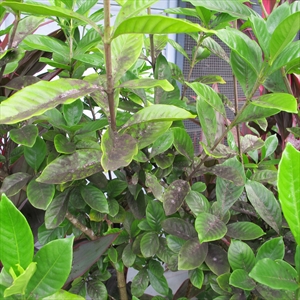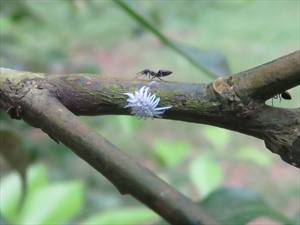Pink wax scale, red wax scale
Pacific Pests, Pathogens, Weeds & Pesticides - Online edition
Pacific Pests, Pathogens, Weeds & Pesticides
Pink wax scale (271)
Ceroplastes rubens
Asia, East Africa, North (Florida and Hawaii), South and Central America, the Caribbean, Europe (on plants grown in the open as well as under cover), Oceania. It is recorded from Australia, Cook Islands, Fiji, French Polynesia, Guam, Kiribati, Marshall Islands, New Caledonia, New Zealand, Niue, Northern Mariana Islands, Palau, Papua New Guinea, Samoa, Solomon Islands, and Vanuatu.
Wide; common on many (at least 80) plant families, particularly fruit and forest trees, and herbaceous ornamentals, but also ferns, orchids and palms. Citrus and mango are the main hosts, but it is also a pest of avocado, cinnamon, coffee, litchi and tea.
Red wax scales feed on the leaves, stems, branches and fruit of its hosts. On leaves, they are found more often on the upper surfaces, frequently in lines along the midribs (Photo 1). As they suck sap from the plants, the excess is expelled as honeydew, covering the foliage with sugary substances, which become colonised by black fungal growth (Photos 2&3). Ants tend the scales to collect the honeydew.
Eggs are red, laid under the pale pink to red hard shell of the female. Active 'crawlers' hatch from the eggs and spread to feeding sites nearby. After they settle down to feed they moult and begin to produce the waxy shell, which is white at first and then pink. They moult several times more before they become adults, slightly longer (3-4 mm) than wide, domed, with four bands or lobes on the sides and a depression at the top. The scale is like a blob of white, cream, pink or reddish wax - hence the name.
In Australia, each female lays about 300 eggs, but it is estimated that 50% of the crawlers are lost in the first 24 hours after hatching. Males are unknown in most countries.
Long distance spread of the scale occurs when crawlers are carried on the wind or by other animals. Spread also occurs on plants moved within the horticultural trade.
Damage occurs in two ways: directly through feeding, and indirectly by buildup of sooty mould fungi on the surface of leaves reducing photosynthesis. Both these actions can result in weakened plants, causing leaf loss, dieback and death. Usually, direct damage is minor, but the scale is a serious pest of citrus in several countries because sooty moulds reduce quality. Similarly, the dirty appearance of ornamental plants makes them appear unsightly and decreases their value in the horticultural trade.
Look for the roundish domed pinkish scales on leaves and stems. They have four bands (or lobes) growing from the sides, shaped like 'ears' with white tips, two of which almost touch each other. Look for the scales in lines on the midribs of leaves. Look for associated sooty moulds, and the presence of ants tending the scales.
NATURAL ENEMIES
There are many natural enemies of pink wax scale, the most important being Anicetus beneficus, a (encyrtid) wasp. This has been introduced successfully from Japan to Australia and Korea, but care is needed as hyperparasitoids exist that attack Anicetus. If Anicetus is introduced to other countries it is important that these hyperparasitoids are not transferred with them. Predators of the pink scale also exist, with Cryptolaemus montrouzieri, a ladybird beetle (Photo 4), being one of the most effective (see Fact Sheet no. 25).
In Australia, Anicetus was slow to spread, so it was introduced into citrus orchards, and orchards of other crops, on parasitsed scales on the umbrella tree (Schefflera actinophylla) where populations are often high.
CULTURAL CONTROL
- Check that nursery stock is free from scales; if present, prune infested parts, and spray with insecticides (see below).
- Prune infested stems, branches and fruits and burn them.
- Destroy ant nests with boiling water, without damaging the plants infested with the scale insect, use commercial ant bait, or synthetic pyrethroids (see below); without the ants, parasitoids and predators will bring about natural control of the scale.
- Prune low branches of trees, and remove weeds, to stop ants from colonising them.
CHEMICAL CONTROL
If Anicetus is present, pesticides should not be used. The wasp is more sensitive to them than the pink scale, which is protected by its waxy shell. If pesticides are required, do the following:
- Use horticultural oil (made from petroleum), white oil (made from vegetable oils), or soap solution (see Fact Sheet no. 56). The spray will not kill all of the scales, but it will allow predators and parasites to increase and bring the scale infestation under control.
- Several soap or oil sprays will be needed to bring the scales under control. If there is a possibility that leaves may be sunburnt because of the soap or oil, spray in later afternoon between 4 and 6 pm. Make soap and oil sprays as follows:
- White oil:
- 3 tablespoons (1/3 cup) cooking oil in 4 litres water.
- 1/2 teaspoon pure hand soap, not detergent.
- Shake well and use.
- Soap:
- Use soap (pure soap, not detergent).
- 5 tablespoons of soap in 4 litres water.
- White oil:
- Commercial horticultural oil can also be used. Note, these sprays work by blocking the breathing holes of insects causing suffocation and death. They are less likely to kill natural enemies as they are quickly broken down in the environment, and also the development of resistance to them is less likely compared to using synthetic pesticides. A second application of soap or oils may be necessary after 3-4 weeks, and further sprays later.
- Use synthetic pyrethroid insecticides to kill ground-nesting ants.
____________________
When using a pesticide, (even a biopesticide) always wear protective clothing and follow the instructions on the product label, such as dosage, timing of application, and pre-harvest interval. Recommendations will vary with the crop and system of cultivation. Expert advice on the most appropriate pesticide to use should always be sought from local agricultural authorities.
AUTHOR Grahame Jackson
Information from Pink wax scale (2012) Department of Agriculture and Fisheries, Queensland Government. (https://www.daf.qld.gov.au/business-priorities/agriculture/plants/fruit-vegetable/insect-pests/pink-wax-scale); and from CABI (2016) Ceroplastes rubens (red wax scale). Crop Protection Compendium. (https://www.cabi.org/cpc/datasheet/12351). Photo 4 Randy Thaman, University of the South Pacific, Fiji.
Produced with support from the Australian Centre for International Agricultural Research under project PC/2010/090: Strengthening integrated crop management research in the Pacific Islands in support of sustainable intensification of high-value crop production, implemented by the University of Queensland and the Secretariat of the Pacific Community.







